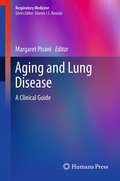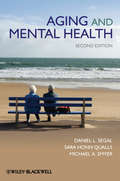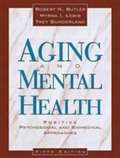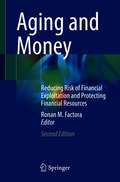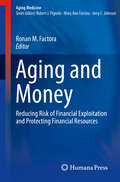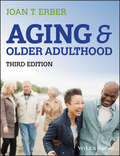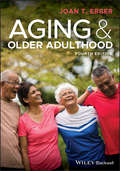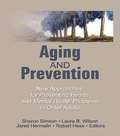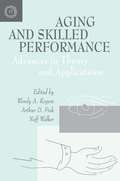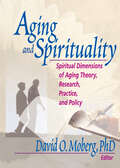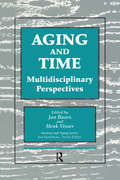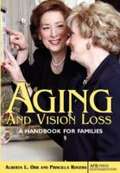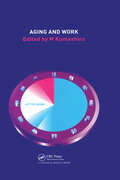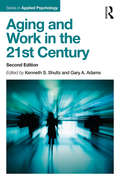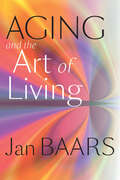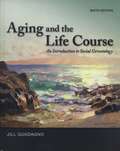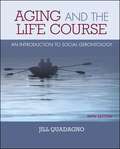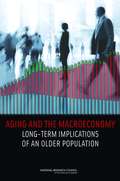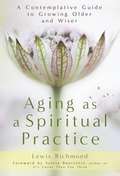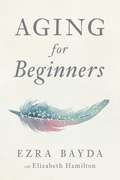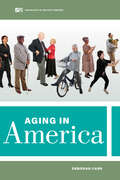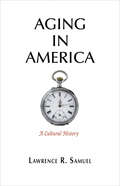- Table View
- List View
Aging and Lung Disease: A Clinical Guide (Respiratory Medicine)
by Margaret PisaniPeople age 65 and older are the fastest growing segment of the U.S. population. In the 2010 census 16% of the population, 50 million people, were age 65 and older. That number is projected to increase to 66 million by the year 2050. Life expectancy has also increased, with recent CDC reports indicating life expectancy at 77.9 years. Age-adjusted death rates have decreased significantly with the largest changes occurring in older patients. Despite these trends, the 10 leading causes of death include several pulmonary etiologies including lung cancer, chronic respiratory diseases, influenza and pneumonia. Aging and Lung Disease: A Clinical Guide is devoted to understanding the impact of respiratory diseases in older patients. It includes reviews of physiology of the aging lung, allergy and immunology of the aging, as well as sleep changes over the life cycle. There are also comprehensive reviews on specific disease topics including chronic obstructive lung disease, lung cancer, atypical mycobacteria, interstitial lung disease, pulmonary hypertension, pulmonary embolism, obstructive sleep apnea, sleep disorders in older patients. Two chapters focus on unique issues in older patients; HIV and lung transplant. Included also are important chapters on assessing functional and cognitive status and end-of-life issues in older patients with lung disease. In addition to outlining the current state of knowledge, each chapter focuses on special considerations when caring for older patients. Of particular interest to pulmonologists, internists, and gerontologists, other readers, such as pulmonary and geriatric nurse practitioners, as well as clinical researchers interested in both pulmonary and aging issues, will find Aging and Lung Disease: A Clinical Guide to be a vital resource for improving their care of older patients with lung disorders.
Aging and Mental Health
by Daniel L. Segal Sara Honn Qualls Michael A. SmyerThis fully revised and updated second edition provides a complete introduction to aging and mental health for psychology students taking courses in aging as well as for academics and practitioners working in the field of gerontology. Offers a comprehensive review of models of mental health and mental illness, along with their implications for treatment of older adultsProvides a pragmatic analysis of assessment and treatment approaches that both students and practitioners will find usefulUses case studies to link theory and practiceFully updated to include discussion of the development and implementation of evidence-based treatment protocols in the field of mental health; the increasing prevalence of cognitive impairment and an appreciation of its implications for a variety of functional behaviors; and a changing understanding of long-term care away from a focus on institutional care and toward a broader spectrum of services
Aging and Mental Health (Understanding Aging)
by Daniel L. Segal Sara Honn Qualls Michael A. SmyerFully updated and revised, this new edition of a highly successful text provides students, clinicians, and academics with a thorough introduction to aging and mental health. The third edition of Aging and Mental Health is filled with new updates and features, including the impact of the DSM-5 on diagnosis and treatment of older adults. Like its predecessors, it uses case examples to introduce readers to the field of aging and mental health. It also provides both a synopsis of basic gerontology needed for clinical work with older adults and an analysis of several facets of aging well. Introductory chapters are followed by a series of chapters that describe the major theoretical models used to understand mental health and mental disorders among older adults. Following entries are devoted to the major forms of mental disorders in later life, with a focus on diagnosis, assessment, and treatment issues. Finally, the book focuses on the settings and contexts of professional mental health practice and on emerging policy issues that affect research and practice. This combination of theory and practice helps readers conceptualize mental health problems in later life and negotiate the complex decisions involved with the assessment and treatment of those problems. Features new material on important topics including positive mental health, hoarding disorder, chronic pain, housing, caregiving, and ethical and legal concerns Substantially revised and updated throughout, including reference to the DSM-5 Offers chapter-end recommendations of websites for further information Includes discussion questions and critical thinking questions at the end of each chapter Aging and Mental Health, Third Edition is an ideal text for advanced undergraduate and graduate students in psychology, for service providers in psychology, psychiatry, social work, and counseling, and for clinicians who are experienced mental health service providers but who have not had much experience working specifically with older adults and their families.
Aging and Mental Health: Positive Psychosocial and Biomedical Approaches
by Robert N. Butler Myrna I. Lewis Trey SunderlandDesigned for professionals working with the elderly, this text provides comprehensive coverage of the ageing process and its effects on mental health. It sets out the nature and problems of old age, including the problems of older people in their families, and explores some of the common emotional problems and psychiatric disorders which can affect the elderly. It also outlines the evaluation, treatment and prevention of some common effects of ageing. There is specific coverage of race, ethnicity, gender, crime, alcoholism and physical disabilities, including deafness and blindness.
Aging and Money: Reducing Risk of Financial Exploitation and Protecting Financial Resources (Aging Medicine Ser.)
by Ronan M. FactoraThis book aims to disseminate and share knowledge about financial exploitation of elders with the purpose of protecting those individuals in our society who are most vulnerable to financial abuse and mistreatment. It instructs practicing clinicians in identification of risk factors, recognition of signs, and implementation of screening methods to protect their patients. This updated edition expands upon and advances the earlier text by including the most recent research and methods used to assess risk of financial exploitation, as well as updates in how the law approaches such cases. It also highlights ways in which community awareness can aid in identifying those most at risk, effectively protecting the elderly community, advocating for those victimized, and pursuing perpetrators to the fullest extent of the law. Professionals from law enforcement, medical clinics, financial institutions, and the legal field are now tasked with acting on suspected situations thanks to increasing recognition of financial abuse and mistreatment of an aging population. This book also guides professionals on how to discuss this information with potential victims. This second edition of Aging and Money expands the knowledge base to highlight the perspectives of different disciplines including professionals in medicine, law, the financial industry, and social services who play an important role in investigating and preventing financial abuse of the elderly.
Aging and Money: Reducing Risk of Financial Exploitation and Protecting Financial Resources (Aging Medicine)
by Ronan M. FactoraIncreasingly, we hear of more and more elders falling victim to financial exploitation. Although this form of elder abuse has been recognized for years, its incidence, prevalence, and impact on the common individual has been only more recently brought to the spotlight. Despite these circumstances, recognition of risk factors and indicators of financial exploitation are not widely disseminated. Additionally, once situations are identified and confronted, the knowledge of what to do next is lacking. These gaps are present within the medical community, law-enforcement, and the finance community - areas where opportunities for recognition and intervention are common. Our elders often have no idea of what to do when they see their own risk or when they fall victim. Aging and Money: Reducing Risk of Financial Exploitation and Protecting Financial Resources helps clinicians to integrate identification of such indicators of abuse into their geriatric assessment as well as guide them in performing an assessment of an individuals' financial decision making capacity when appropriate. Aging and Money: Reducing Risk of Financial Exploitation and Protecting Financial Resources is an essential new text that provides the practicing clinician with information on identifying risk factors and clinical clues associated with financial exploitation and how to incorporate these steps into their practice.
Aging and Older Adulthood (Wiley Desktop Editions Ser.)
by Joan T. ErberThe third edition of this essential text has been updated and expanded with new material that reflects the most recent developments in the field, and explores our current understanding of a broad range of topics related to aging and older adulthood. Fresh edition includes updated content such as revised case histories and reworked material on key concepts and research applications Retains the winning format of the second edition, with chapter contents framed by individual histories Dual models add cohesiveness to the presentation of theory Thematic structure facilitates reader comprehension Instructor resources provided online upon publication at www.wiley.com/go/erber
Aging and Older Adulthood (Wiley Desktop Editions Ser.)
by Joan T. ErberReflects the most important theoretical foundations and research directions concerning aging and older adulthood This authoritative volume provides the latest insights into, and theoretical interpretation of, our understanding of the human aging process. Newly updated and revised, this edition of the well-established student textbook offers relatable scenarios that touch upon real-world issues faced by older adults and their families. The book explains how research studies attempt to answer questions of both theoretical and practical importance as they relate to aging and older adulthood, and it explains the hypotheses and findings of the studies in a manner that is comprehensible to readers of all levels of research experience. Aging and Older Adulthood begins by describing the demographic characteristics of the older population, and follows with a chapter on theoretical models that apply to the study of adult development and aging, as well as approaches commonly taken to conduct research and ethical concerns involved in the study of this group. It then offers a series of chapters exploring biological aging, sensation perception and attention, memory, intellectual functioning, cognition and real-world problem-solving, personality and coping, social interaction and social ties, lifestyles and retirement, mental health and psychotherapy, and death and bereavement. The final chapter looks at aging in the future. Each chapter includes fully updated research findings, as well as new and expanded coverage of concepts and ideas in areas such as neuroscience, and diabetes. New edition of a highly respected text exploring our contemporary understanding of a broad range of topics related to older adulthood and the psychology of aging Offers thematic treatment of core issues including health, sensory perception, memory, intellect, social interactions, employment and retirement, and mental health Uses a dual lens of two models – the selective optimization with compensation model and the ecological model – to provide cohesiveness to the presentation of both theoretical and applied material Introduces each chapter with a relevant real-world scenario and refers back to it throughout the chapter Includes pedagogical feature boxes that reflect current understanding of contemporary issues in the field as well as key points and issues for further discussion Aging and Older Adulthood, 4th Edition is an excellent text for upper division undergraduate and graduate courses focusing on the older adulthood and aging, the psychology of aging, gerontological studies, and lifespan development.
Aging and Popular Music in Europe (Routledge Studies in Popular Music)
by Abigail Gardner Ros JenningsOpening up the dialogue between popular music studies and aging studies, this book offers a major exploration of age and popular music across Europe. Using a variety of methods to illustrate how age within popular music is contingent and compelling, the volume explores how it provokes curation and devotion across a variety of sites and artists who record in several European languages, and genres including waltz music, electronica, pop, folk, rap, and the French ‘chanson.’ Visiting the many ways in which age is problematized, revered, and performed within Europe in relation to popular music, case studies analyze: French touring shows of popular music stars from the 1960s; André Rieu’s annual Vrijthof concerts in the Netherlands; Kraftwerk and Björk’s appearances at renowned art museums as curated objects; queer approaches to popular music space and time; British folk music inheritances; pan-European strategies of stardom and career longevity; and inheritance and post-colonial hauntings of race and identity. The book works with the notion of travelling, across borders, genres, sexualities, and media, highlighting the visibility of the aging body across a variety of European sites in order to establish popular music through the lens of age as a positive methodology with which to approach popular music cultures, and to offer a counter-narrative to age as decline. This book will appeal to scholars of popular music, popular culture, media studies, cultural studies, aging studies, and cultural gerontology.
Aging and Prevention: New Approaches for Preventing Health and Mental Health Problems in Older Adults
by Robert E HessRenowned specialists on aging explore the meaning of prevention and provide practical information about programs and services for the elderly. Interesting chapters focus on the prevention of long-term care institutionalization, alternative health delivery systems, informal support networks, and the prevention of domestic neglect and abuse of elderly adults.
Aging and Skilled Performance: Advances in Theory and Applications
by Wendy A. Rogers Arthur D. Fisk Neff WalkerThe term "skill" encompasses an array of topics and issues. For example, individuals are skilled in a variety of domains such as chess, typing, air traffic control, or knitting; researchers study skill in a variety of ways, including speed of acquisition, accuracy of performance, and retention over time; and there are a variety of approaches to the study of skill such as computer modeling or experimental analysis. Contributing to the understanding of whether, how, when, and why skills may decline as a function of age is the goal of this volume. This book is based on the Aging and Skill Conference sponsored by the Center for Applied Cognitive Research on Aging. The broad focus of the conference was to discuss cognitive theories underlying age-related skill acquisition, transfer, and retention and to discuss applications of these theories to such issues as age-adaptive training, compensatory strategies and devices, and utilization of new and existing technology. The contributors were asked to discuss the cognitive theory relevant to their topic, explain how the theory informs the field about aging, examine where gaps exist among general cognitive theory in this area and theories of aging, and demonstrate the practical relevance of the theory to enhancing or enabling activities of daily living--for work, home, or leisure--for older adults. This is the first book to focus exclusively on aging and skill. It covers a range of abilities, provides the theoretical basis for the current status of age-related differences in skill, and offers direct evidence of the applicability of research on proficiency to aspects of daily living. Each chapter was written either by an expert in the field of aging, or by an expert in the field of skill--many expert in both areas.
Aging and Social Expenditure in the Major Industrial Countries, 1980-2025
by Peter S. Heller Richard Hemming Peter W. KohnertFinancial report from the IMF
Aging and Spirituality: Spiritual Dimensions of Aging Theory, Research, Practice, and Policy
by David O. MobergExplore the spiritual dimensions of aging through science, theory, and practice!During the later years of life, many people devote energy to a process of spiritual awakening and self-discovery. Yet their family, friends, clergy, and the helping professionals who work with them are not always prepared to understand or deal with the spiritual concerns of their clients. Aging and Spirituality provides a unique, far-reaching overview of this long-neglected field.Divided into four independent but interwoven sections, this landmark book covers the spiritual realm with scientific rigor and deep human understanding. Aging and Spirituality comprehensively surveys the issues of spirituality, from the groundwork of basic definitions to detailed assessments of the role spirituality plays in the lives of the elderly and suggested directions for further research. This book's unique approach combines scholarly research and practical nuts-and-bolts suggestions for service delivery. By drawing from many disciplines and professions, it offers fresh perspectives to even those practitioners already familiar with the most effective spiritual techniques their own field can offer. Aging and Spirituality answers such common questions as: What are the spiritual needs of people later in life? Is there any solid evidence that prayer changes things? How is spirituality related to physical and mental health? Does spirituality matter when people know they are dying? How can we measure spiritual wellness and assess the outcomes of activities intended to enhance it? Will attention to spirituality aggravate or alleviate the losses--of friends, family, health, youth--that so often occur during old age?Aging and Spirituality provides a much-needed resource for health care professionals, clergy, social workers, and counselors working with geriatric clients. By integrating spiritual issues into the theoretical framework of social gerontology, Aging and Spirituality will help you understand the scientific foundations, practical applications, and public policy implications of spirituality for older adults.
Aging and Time: Multidisciplinary Perspectives, Illustrated Edition
by Jan BaarsThe aim of this volume is to revitalise the debate about the concepts of time implicit in the study of aging. The many problems related to aging and the aged put an enormous pressure on the gerontological community to come up with practical applications and solutions. In considering research findings, we must keep in mind the basic assumptions that shape and influence even the most obvious statements about aging. In this multidisciplinary volume, the contributors take on the important task of exploring real issues concerning temporal concepts and approaches to aging; and the concepts of time that are used in thinking about aging determine to a large extent the way aging is approached. Most studies of aging still use a chronological approach to define populations for research purposes (that is, to determine which "aged" should be studied) and to establish how people's characteristics (social, economic, health and so forth) change as a function of age. This approach may lead to an accumulation of data, but does not in itself lead to explanatory knowledge. The step from chronological time to chronological age should be taken cautiously if we want to consider aging processes seriously, especially because chronological age is widely used in contemporary societies as a basis for regulating all kinds of processes, with many consequences for individuals. The arguments presented here do not deny the finitude of human life, nor do they deny that "aging" can be observed in any individual if we compare the characteristics of that person over a relatively long period. The question is how to approach these themes to get a better understanding. To achieve this, we need to understand the specific significance and relativity of chronological time and uncover unfounded deductions about time in relation to aging. This book will be of interested to students and professors of the social sciences, humanities and aging, including the methodology of aging studies; professionals working in the field of aging, including sociologists, psychologists and biologists.
Aging and Vision Loss: A Handbook for Families
by Alberta Orr Priscilla RogersAs the number of older persons experiencing vision loss continues to soar over the upcoming years, all of us may find that a family member or friend we care about has become visually impaired. Aging and Vision Loss contains reassuring, supportive, and helpful information on meeting the needs of the older person and family caregivers as well.
Aging and Work
by Masaharu KumashiroImprovements in health care and quality of life in recent years have led to a marked aging of the world's population, especially in well-developed regions. In the near future, this problem will spread to developing countries. The growing need to promote the health and function of aging workers presents new challenges as well as new opportunities.
Aging and Work in the 21st Century (Applied Psychology Series)
by Kenneth S. Shultz Gary A. AdamsAging and Work in the 21st Century, 2nd edition, reviews, summarizes, and integrates existing literature from various disciplines with regard to aging and work, but with a focus on recent advances in the field. Chapter authors, all leading experts within their respective areas, provide recommendations for future research, practice, and/or public policy. Fully revised and updated, the second edition takes up many of the same critical topics addressed in the first edition, and incorporates twelve new authors across the volume and three brand new chapters on recruitment and retention, legal issues, and global issues in work and aging. The intended audience is advanced undergraduate and graduate students, as well as researchers in the disciplines of industrial and organizational psychology; developmental psychology; gerontology; sociology; economics; and social work. Older worker advocate organizations, such as AARP, will also take interest in this edited book.
Aging and the Art of Living
by Jan BaarsBaars explores philosophers from Plato to Foucault as they consider the meaning of aging—and wisdom—in our society.In this deeply considered meditation on aging in Western culture, Jan Baars argues that, in today’s world, living longer does not necessarily mean living better. He contends that there has been an overall loss of respect for aging, to the point that understanding and "dealing with" aging people has become a process focused on the decline of potential and the advance of disease rather than on the accumulation of wisdom and the creation of new skills. To make his case, Baars compares and contrasts the works of such modern-era thinkers as Foucault, Heidegger, and Husserl with the thought of Plato, Aristotle, Sophocles, Cicero, and other Ancient and Stoic philosophers. He shows how people in the classical period—less able to control health hazards—had a far better sense of the provisional nature of living, which led to a philosophical and religious emphasis on cultivating the art of living and the idea of wisdom. This is not to say that modern society’s assessments of aging are insignificant, but they do need to balance an emphasis on the measuring of age with the concept of "living in time." Gerontologists, philosophers, and students will find Baars' discussion to be a powerful, perceptive conversation starter.
Aging and the Life Course: An Introduction to Social Gerontology
by Jill S. QuadagnoJill Quadagno's groundbreaking text Aging and the Life Course examines the relationship between quality of life in old age and its experiential catalysts. Throughout the text an emphasis is placed on the intersectionality of race, class, gender, and culture, and how these classifications affect quality of life. Students will come away with a broad background for understanding crucial and current policy debates.
Aging and the Life Course: An Introduction to Social Gerontology (5th Edition)
by Jill QuadagnoAging and the Life Course is a comprehensive interdisciplinary text in social gerontology. It provides students with a firm grounding in methodological and theoretical issues associated with aging and examines changes in social roles, relationships and the biological and psychological process that occur as people grow older. It also considers all major life transitions including retirement, widowhood, grandparenting, and changes in living arrangements. In addition, this text considers the economic and political issues that influence the context in which people grow old. Although the primary focus is on the U. S. , considerable material on aging worldwide is included. Unique features include four featured boxes, a life course perspective and an emphasis on inequality by race, ethnicity and gender.
Aging and the Macroeconomy
by National Research Council Committee on Population Division on Engineering and Physical Sciences Division of Behavioral and Social Sciences and Education Board on Mathematical Sciences And Their Applications Committee on the Long-Run Macro-Economic Effects of the Aging U.S. PopulationThe United States is in the midst of a major demographic shift. In the coming decades, people aged 65 and over will make up an increasingly large percentage of the population: The ratio of people aged 65+ to people aged 20-64 will rise by 80%. This shift is happening for two reasons: people are living longer, and many couples are choosing to have fewer children and to have those children somewhat later in life. The resulting demographic shift will present the nation with economic challenges, both to absorb the costs and to leverage the benefits of an aging population. Aging and the Macroeconomy: Long-Term Implications of an Older Population presents the fundamental factors driving the aging of the U.S. population, as well as its societal implications and likely long-term macroeconomic effects in a global context. The report finds that, while population aging does not pose an insurmountable challenge to the nation, it is imperative that sensible policies are implemented soon to allow companies and households to respond. It offers four practical approaches for preparing resources to support the future consumption of households and for adapting to the new economic landscape.
Aging as a Spiritual Practice: A Contemplative Guide to Growing Older and Wiser
by Lewis RichmondThe bestselling author of Work as a Spiritual Practice presents a new vision of the aging process, awakening a spirit of fulfillment and transformation. Everything changes. For Buddhist priest and meditation teacher Lewis Richmond, this fundamental Buddhist tenet is the basis for a new inner road map that emerges in the later years, charting an understanding that can bring new possibilities, fresh beginnings, and a wealth of appreciation and gratitude for the life journey itself. In Aging as a Spiritual Practice, Richmond acknowledges the fear, anger, and sorrow many people experience when they must confront the indignities of their aging bodies and the unknowns associated with mortality. This wise, compassionate book guides readers through the four key stages of aging- such as "Lightning Strikes" (the moment we wake up to our aging)-as well as the processes of adapting to change, letting go of who we were, embracing who we are, and appreciating our unique life chapters. Unlike many philosophical works on aging, however, this one incorporates illuminating facts from scientific researchers, doctors, and psychologists, as well as contemplative practices and guided meditations on aging's various challenges and rewards. The tandem of maintaining a healthy body and healthy relationships, infused with an active spiritual life, is explored in rejuvenating detail. Breath by breath, moment by moment, Richmond's teachings inspire limitless opportunities for a joy that transcends age. .
Aging for Beginners
by Ezra Bayda Elizabeth HamiltonWe all grow old. This book teaches us how to take advantage of a new phase of life: a phase of renewal and inner exploration.We’re all beginners when it comes to aging. And although the fact that we are in new territory can certainly contribute to the difficulties in dealing with getting older, it can also have a very positive side. Aging can be seen as a new phase of our life: a phase of renewal. Nowhere is this more evident than in our opportunity to devote more time to reflection and inner exploration. The result, regardless of whatever physical limitations we may be experiencing, is the possibility of cultivating and living increasingly from kindness and gratitude—two of the essential qualities of a life of satisfaction and equanimity. With techniques that are both simple and richly unfolded, this book will help readers: • learn the subtle art of being with pain • uncover the fears that amplify suffering • tap into the true sources of meaningfulness and joy
Aging in America (Sociology in the Twenty-First Century #8)
by Deborah CarrThe aging of America will reshape how we live and will transform nearly every aspect of contemporary society. Renowned life course sociologist Deborah Carr provides a lively, nuanced, and timely portrait of aging in the United States. The US population is older than ever before, raising new challenges for families, caregivers, health care systems, and social programs like Social Security and Medicare. Organized in seven chapters, Aging in America covers these topics: the history of aging and the development of theoretical approacheshow cultural changes shape our views on agingthe demographic characteristics of older adults todayolder adults' family lives and social relationshipsthe health of older adults and social disparities in who gets sickhow public policies affect the well-being of older adults and their familieshow baby boomers, Gen Xers, and millennials will experience old age Drawing on state-of-the-art data, current events, and pop culture, this portrait of an aging population challenges outdated myths and vividly shows how future cohorts of older adults will differ from the generations before them.
Aging in America: A Cultural History
by Lawrence R. SamuelAging is a preoccupation shared by beauty bloggers, serious journalists, scientists, doctors, celebrities—arguably all of adult America, given the pervasiveness of the crusade against it in popular culture and the media. We take our youth-oriented culture as a given but, as Lawrence R. Samuel argues, this was not always the case. Old age was revered in early America, in part because it was so rare. Indeed, it was not until the 1960s, according to Samuel, that the story of aging in America became the one we are most familiar with today: aging is a disease that science will one day cure, and in the meantime, signs of aging should be prevented, masked, and treated as a source of shame.By tracing the story of aging in the United States over the course of the last half century, Samuel vividly demonstrates the ways in which getting older tangibly contradicts the prevailing social values and attitudes of our youth-obsessed culture. As a result, tens of millions of adults approaching their sixties and seventies in this decade do not know how to age, as they were never prepared to do so.Despite recent trends that suggest a more positive outlook, getting old is still viewed in terms of physical and cognitive decline, resulting in discrimination in the workplace and marginalization in social life. Samuels concludes Aging in America by exhorting his fellow baby boomers to use their economic clout and sheer numbers to change the narrative of aging in America.
